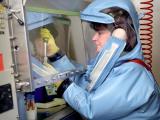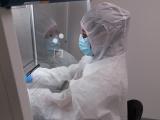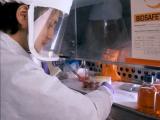Nearly a year has passed since the Obama administration announced a moratorium on controversial "gain-of-function" (GOF) research, and the advisory board charged with coming up with guidance for how the government funds such projects and weighs the risks and benefits met this week to hear updates from working groups and receive more input on their deliberations.
The National Science Advisory Board for Biosecurity (NSABB) is playing the lead role in formulating policies for work on studies that enhance pathogenicity, transmissibility, or host range of a pathogen with the goals of better understanding disease and developing vaccines and drugs.
The experiments have triggered "dual-use" worries—that methods could be used not only for beneficial purposes but also to engineer bioterror threats. Some experts have also raised concerns about an intentional or accidental release of the experimental pathogens, especially in light of recent safety lapses involving federal facilities.
The Obama administration first announced the moratorium on Oct 17, and early indications were that it would take about a year for the NSABB to hammer out a federal funding policy and a risk-benefit assessment. However, the latest estimate is for the recommendations and risk assessment to be finalized in the spring of 2016.
Last December the administration allowed a handful of GOF studies to resume, some involving Middle East respiratory syndrome coronavirus (MERS-CoV) and influenza. An NSABB working group is tackling the funding policy recommendations, and in March the government awarded a $1.1 million contract to Gryphon Scientific to formally assess the risks and benefits of GOF work.
The NSABB's meeting on Oct 28 was streamed live online and will soon be available in an online audio archive. Christopher Viggiani, PhD, the NSABB's executive director at the National Institutes of Health (NIH), said the group was briefed on the progress of funding policy development and received an update on Gryphon's work so far on the risk-benefit assessment. He said members also discussed a host of related ethical, legal, and policy issues and heard input from the public.
Timeline for next steps
During the meeting the NSABB also aired a timeline for the next steps, Viggiani said. The working group is expected to start reviewing the preliminary risk-benefit assessment in November. And at its next meeting on Jan 7 and 8, the NSABB is expected to review the final version of the risk-benefit assessment and the working group's draft funding policy recommendations.
Viggiani said both items will also be discussed at a National Academy of Sciences (NAS) meeting on Mar 10 and 11, and the NSABB tentatively expects to present its final recommendation tentatively in the spring of 2016. The NAS meeting will be the second devoted to discussing GOF issues. The first debate was held in December 2014.
In a blog post on the latest NSABB developments, Carrie Wolinetz, PhD, the NIH's associate director for science policy, wrote that the GOF debate is about public trust in science. She added that new discoveries and technology are promising, but they test policy frameworks. "It is an exciting time, but also a sobering one for those in science policy. It is our job to help ensure that science can advance rapidly as well as safely, ethically, and responsibly."
Discussions in the medical literature
Meanwhile, scientists continue to weigh in on the GOF debate in two reports in the Sep 27 online edition of Journal of Infectious Diseases. One group of authors built a case for including clinicians in GOF discussions, while the others detailed six recommendations from an Infectious Diseases Society of America (IDSA) working group.
In the first report, two scientists with military labs and one from the University of Pittsburgh Medical Center's Center for Health Security wrote that microbiologists and policy specialists have guided much of the GOF discussion, but more input is needed from medical and public health practitioners, because they are often the "end users" of the products of such research.
In the debate that's transpired so far, the ramifications for the research on practicing clinicians hasn't been clarified, the group wrote.
They said GOF research helps ensure that clinicians have the tools to respond to outbreaks, and that decisions affecting what type of research is allowed to continue directly affect clinicians' work. They added, howver, that clinicians will also need to be acutely aware of the risks posed by the work.
The second editorial is from the IDSA's working group on dual-use research of concern and lists six key recommendations for the NSABB as it conduct its GOF work. The group first shared its recommendations with the NSABB in an Aug 10 letter.
Their recommendations include focusing on experiments of special concern, and they worried that under the NSABB's current framework, work to produce high-growth vaccine virus strains would likely be hampered. They also urged the group to address uncertainties and seek a wide array of expertise in weighing risks and benefits.
Other recommendations included accounting for public perception of science during risk discussions, considering the framework's impact on science in the face of potential GOF limits, and finding ways to improve the safety of GOF.
See also:
Sep 28 NSABB meeting agenda
Sep 25 Carrie Wolinetz blog post
NSABB home page
Sep 27 J Infect Dis abstract
Sep 27 J Infect Dis editorial



















